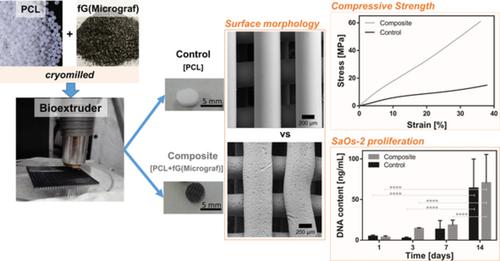当前位置:
X-MOL 学术
›
J. Biomed. Mater. Res. Part B Appl. Biomater.
›
论文详情
Our official English website, www.x-mol.net, welcomes your
feedback! (Note: you will need to create a separate account there.)
3D‐printed cryomilled poly(ε‐caprolactone)/graphene composite scaffolds for bone tissue regeneration
Journal of Biomedical Materials Research Part B: Applied Biomaterials ( IF 3.2 ) Pub Date : 2020-11-25 , DOI: 10.1002/jbm.b.34761 Daniela Dias 1, 2 , Ana C Vale 1, 2 , Eunice P F Cunha 3 , Maria C Paiva 3 , Rui L Reis 1, 2 , Cedryck Vaquette 4 , Natália M Alves 1, 2
Journal of Biomedical Materials Research Part B: Applied Biomaterials ( IF 3.2 ) Pub Date : 2020-11-25 , DOI: 10.1002/jbm.b.34761 Daniela Dias 1, 2 , Ana C Vale 1, 2 , Eunice P F Cunha 3 , Maria C Paiva 3 , Rui L Reis 1, 2 , Cedryck Vaquette 4 , Natália M Alves 1, 2
Affiliation

|
In this study, composite scaffolds based on poly(caprolactone) (PCL) and non‐covalently functionalized few‐layer graphene (FLG) were manufactured by an extrusion‐based system for the first time. For that, functionalized FLG powder was obtained through the evaporation of a functionalized FLG aqueous suspension prepared from a graphite precursor. Cryomilling was shown to be an efficient mixing method, producing a homogeneous dispersion of FLG particles onto the PCL polymeric matrix. Thereafter, fused deposition modeling (FDM) was used to print 3D scaffolds and their morphology, thermal, biodegradability, mechanical, and cytotoxicity properties were analysed. The presence of functionalized FLG demonstrated to induce slight changes in the microstructure of the scaffold, did not affect the thermal stability and enhanced significantly the compressive modulus. The composite scaffolds presented a porosity of around 40% and a mean pore size in the range of 300 μm. The cell viability and proliferation of SaOs‐2 cells were assessed and the results showed good cell viability and long‐term proliferation onto produced composite scaffolds. Therefore, these new FLG/PCL scaffolds comprised adequate morphological, thermal, mechanical, and biological properties to be used in bone tissue regeneration.
中文翻译:

用于骨组织再生的 3D 打印低温研磨聚(ε-己内酯)/石墨烯复合支架
在这项研究中,首次通过基于挤出的系统制造了基于聚(己内酯)(PCL)和非共价功能化的少层石墨烯(FLG)的复合支架。为此,功能化 FLG 粉末是通过蒸发由石墨前体制备的功能化 FLG 水悬浮液获得的。低温研磨被证明是一种有效的混合方法,可将 FLG 颗粒均匀分散到 PCL 聚合物基质上。此后,使用熔融沉积建模 (FDM) 打印 3D 支架,并分析了它们的形态、热、生物降解性、机械和细胞毒性特性。功能化 FLG 的存在证明会引起支架微观结构的轻微变化,不影响热稳定性并显着提高压缩模量。复合支架的孔隙率约为 40%,平均孔径在 300 μm 范围内。对 SaOs-2 细胞的细胞活力和增殖进行了评估,结果表明在生产的复合支架上具有良好的细胞活力和长期增殖能力。因此,这些新的 FLG/PCL 支架具有足够的形态、热、机械和生物学特性,可用于骨组织再生。
更新日期:2020-11-25
中文翻译:

用于骨组织再生的 3D 打印低温研磨聚(ε-己内酯)/石墨烯复合支架
在这项研究中,首次通过基于挤出的系统制造了基于聚(己内酯)(PCL)和非共价功能化的少层石墨烯(FLG)的复合支架。为此,功能化 FLG 粉末是通过蒸发由石墨前体制备的功能化 FLG 水悬浮液获得的。低温研磨被证明是一种有效的混合方法,可将 FLG 颗粒均匀分散到 PCL 聚合物基质上。此后,使用熔融沉积建模 (FDM) 打印 3D 支架,并分析了它们的形态、热、生物降解性、机械和细胞毒性特性。功能化 FLG 的存在证明会引起支架微观结构的轻微变化,不影响热稳定性并显着提高压缩模量。复合支架的孔隙率约为 40%,平均孔径在 300 μm 范围内。对 SaOs-2 细胞的细胞活力和增殖进行了评估,结果表明在生产的复合支架上具有良好的细胞活力和长期增殖能力。因此,这些新的 FLG/PCL 支架具有足够的形态、热、机械和生物学特性,可用于骨组织再生。











































 京公网安备 11010802027423号
京公网安备 11010802027423号